 |
Bhutan's
Education |
|
 |
Bhutan Information |
|
|
 |
|
Samtse:
Schoolwise in Sengdhen
|

|
Come
2007 and Bhutan will cross a significant milestone in its evolution as
a nation.
The
installation of Gongsar Ugyen Wangchuck as Bhutan's first hereditary
monarch of the Wangchuck dynasty following the unification of the country
was the beginning of a brave new world for this jewel of the Himalayas.
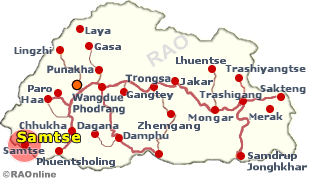 |
The
covenant sealed on December 17, 1907, in Punakha's Palace of Bliss was, among other things, the affirmation of the most essential factor in
the creation of a nation-state - the sense of solidarity.
Since
then, diverse enlightened initiatives and instruments envisioned and pursued
from the kingdom's serthri (Golden Throne) have refined and reinforced
a consciousness of nation and national identity. |
|
The
early acknowledgement and provision of education as a powerful instrument
in the creation and advancement of the idea of nation and nationhood has
produced rich dividends. A call to engage the marvels of the Bhutanese
mind, to affirm and celebrate the inner and the essential, to brave and
to beckon the possible and the positive of the outer, and to commit the
genius and creativity of the Bhutanese people has been a decision at once
enlightened, at once courageous.
 |
|
School
near Thimphu |
The
national flag adorns the Bhutanese skies, the national anthem beckons the
pupils in their tens of thousands, six days a week, nine months in a year
across the length and breadth of our country calling us unto ourselves.
The courses and curricula, the songs and the dances, the prayers and the
observances, ceremonies and celebrations all serve to bring us home to
ourselves and to our priorities. They bring us together - in our actions,
in our thoughts, in our imaginations.
| Sengdhen
Community Primary School in Samtse's Dorokha Dungkhag |
 |
Sengdhen
Community Primary School in Samtse's Dorokha Dungkhag is a case in point.
Designed to bring the light of learning to one of the most disadvantaged
communities in one of the remotest corners of the country, this school
is the Lhop's window to the rest of Bhutan and to the world. Followers
of a unique way of life with a distinct language, beliefs and rituals,
customs and costumes, the Lhops or Doyas inhabit the seven villages
of Jigme, Singye, Wangchuck, Sanglung, Satakha, Sengdhen and Lapchegaon
that consist of some 120 households with about 1,000 members in all.
Deeply
inward-looking and rather exclusive, the community chose to remain on its
own for hundreds of years until the government tried to gently draw it
into the mainstream of national life.
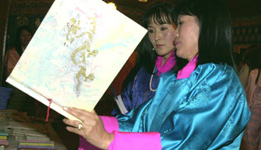 |
HM Queen Ashi Dorji Wangmo Wangchuck
and
HRH Ashi Kesang Wangmo Wangchuck |
| The
establishment of the community school at Sengdhen in 1987 has proved a
significant step in the direction of weaving the Lhop community into the
collective Bhutanese consciousness. The personal initiative of Her Majesty Queen
Ashi Dorji Wangmo Wangchuck and critical inputs of the Tarayana
Foundation have been instrumental in bringing the community into the
national fold. |
|
As
dawn breaks and the whistle blows, the 393 boarders scurry and scramble
towards the lone water-tap that feeds the 500 plus school population.
A quick splash on the face and the little ones run, tying their belt and
pulling the gho as morning study begins. A round of supervised study, some
cleaning and it is time for breakfast.
| As
Jigme Tshering's steaming phikka (black tea) irrigates his soya
power, the vapours mingle with those of the dew-soaked dust as it receives
the first light of Sengdhen's Autumn sun.
Wet
or dry, warm or cold, the near-end of the football field is the dining
facility for the biggest boarding community primary school in the country.
But Jigme and his friends sit, stand and squat as they roll soya-flour
into a ball and relish a sip of phikka as they attend to the next impending
bell.
Eight
o'clock and this is assembly time. All the 485 students and six regular
teachers plus three apprentice teachers and a non-formal education teacher
are in attendance, barring a few. The sound of coughing and signs of
cold are all too obvious. Many feet are bare. |
|
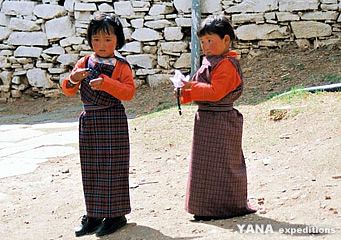 |
Ordinary
slippers are the order of the day. There are two speakers this morning.
Jagat Bhujel aims to be a teacher after finishing his studies. He extols
the value of education and the role of teachers. Tshering Dema highlights
the importance of the national language and the need to promote it in her
confident Dzongkha.
As
the captain calls the house to order and unfurls the national flag, the
best part of the assembly is, of course, the singing of the national anthem
which resounds in the little village and immediately connects everybody
to a bigger reality and a sublimer entity.
Sengdhen
becomes Bhutan. The classrooms are minimally furnished and the facilities
are spartan. The walls are a sparse text of mathematical symbols, science
formulae, grammatical rules, some proverbs, poems, and health messages
and teaching aids. The mid-November wind already whistles through the windows
and corridors. The classrooms echo with the sound of learning as teaching
goes on.
| In
isolated Sengdhen, the children's world is essentially defined by the teachers.
They are the only reality beyond the children's family, neighbours and
a few others further afield. That explains why most children do not see
themselves doing anything except becoming teachers in the future.
Whether
it is Sonam Choden or Sherub Dorji or Jigme Tshering of Class I, Sangay
Pema of PP, or Mindu Zam of Class VI, teaching is their life's goal. Only
Santa Kumar sees himself as a doctor and Chal Singh Lama aspires to be
a driver. |
|
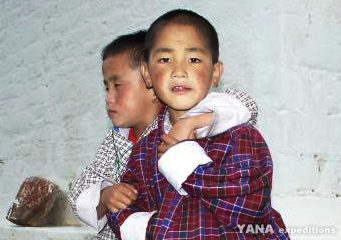 |
A
visit to their hostel in the evening will be enough to challenge even the
most robust optimism.
The
batteries of the solar-powered equipment have served the school faithfully,
but replacing the crippled ones has been a proposition too expensive to
afford.
The
best the children do, therefore, is to improvise. But it is improvisation
stretched to its limits. Groups of eight children sit around a low, feeble
kerosene lamp and do their homework or try to goad their eyes to see the
letters. There are smaller groups at times. Some have a half-burnt candle-stick
that rushes to its end in the wake of the night-wind that takes liberties
with the open windows. Others have no resource. They do the next best thing
- huddle up in thin blankets and invite sleep on rough wooden beds. One
cannot but wonder how these children will compete with their peers in better
surroundings in the more advanced centres. There are no secure doors, but
the head-teacher assures that there have been absolutely no untoward incidents
of any kind so far.
It
has been achieving better than average results in all the Class VI examinations
and the pass percentage in other classes is quite high. The cultural and
sporting life of the school is very rich. It was the winner of the inter-school
football and volleyball tournament in Panbari recently. It hosts scouting
and sports events regularly.
"Perennial
shortage of teachers is our biggest problem," longest-serving head-teacher
Kinley Tenzin agonises. "Next is the challenge of transporting over 70
tonnes of food items from Samtse to feed our big family of close to 400
members."
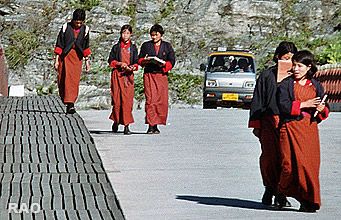 |
| School girls in Wangduephodrang |
| But
the adversities of difficult places are compensated for in other ways.
Coming from different parts of the country, the teachers have developed
a wonderful culture of cooperation, caring and sharing. They are deeply
committed to the welfare of the children so evident in the many ways they
relate to and look after the children many of whom are as young as seven
years of age, yet stay in the hostel. |
|
"Teaching the children of this remote
place is both a joy as well as a challenge" to Siwan Rai, who has been
here for over six years. "The innocence of the children and their respect
are unforgettable" for others.
For
70-year old Mongal Dhoj Rai, who donated the land to build the school and
the upcoming lhakhang, the coming of the school to their locality has provided
"eyes to the community". Dorji Doya is "deeply grateful to the government
for giving us a school in our poor community".
Some
331 students have graduated from Class VI since the school admitted 108
children in PP in 1987. The non-formal education programme has made its
own critical contribution. The teachers are convinced that the advent of
the school has brought about visible changes in the general life of the
Lhop community.
 |
|
School
in Haa |
Events
like the celebration of our national foundation day or the birthday of
His Majesty the King are much-anticipated occasions. The whole community
converges on the school grounds to partake of the joy of the celebrations
and to be part of the larger idea that is the nation and the symbols of
our national life. Sengdhen Community Primary School has been a bulwark
for fostering a sense of national consciousness in this fabled part of
this land.
| Contributed
by Thakur Singh Powdyel for KUENSEL, Bhutan's national newspaper, 2006 |
 |
top
|
Links |
 |
 |
 |
External
links |
 |
TARAYANA
FOUNDATION
|
|
|









